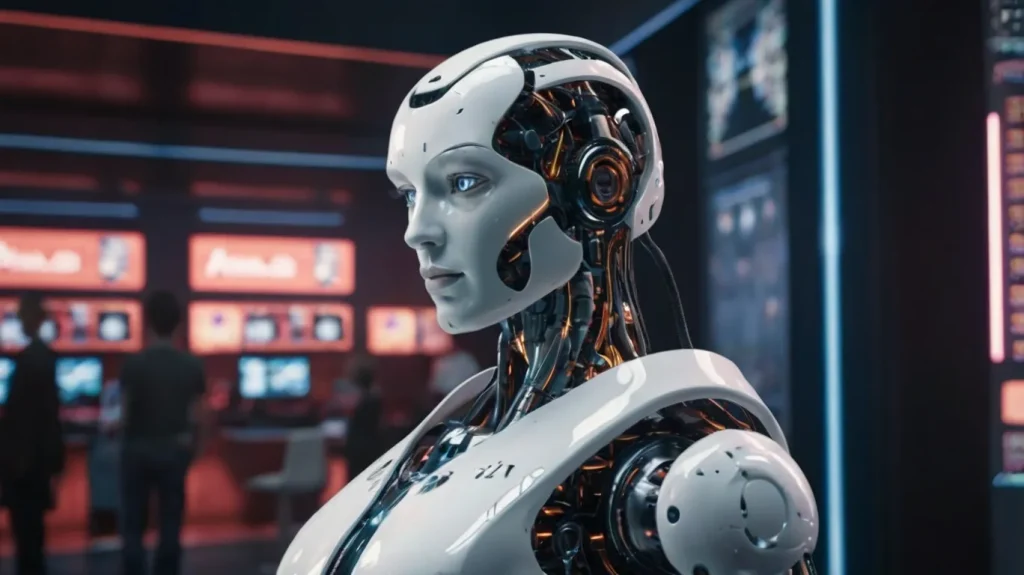The gaming industry has always thrived on innovation. From the first pixelated characters that ran across our screens to today’s hyper-realistic worlds that blur the line between reality and fantasy, every leap forward has been powered by technology. But right now, we are standing at the edge of one of the most significant revolutions in gaming history: the rise of Artificial Intelligence (AI) and robotics in game development. If you think gaming is already immersive, just wait until you see what happens when machines don’t just follow instructions but actually “learn,” “adapt,” and “create.” Whether you’re a player, a developer, or someone who’s just fascinated by tech, understanding how AI and robotics are reshaping this space is like peeking into the future of entertainment itself.
The Pain Points of Traditional Game Development
For decades, game development has been a blend of creativity, engineering, and sheer human effort. Developers spend years coding scripts, building assets, and testing endless scenarios to deliver games that run smoothly and feel engaging. But the pain points have always been there: repetitive coding, unpredictable bugs, limitations of human imagination, and the enormous time it takes to create expansive worlds. Anyone who has followed the industry knows the heartbreak of delayed launches, buggy releases, or ambitious projects that collapse under their own weight. In a market where players expect updates every few weeks and flawless gameplay across multiple devices, traditional workflows often buckle under pressure. And this is exactly where AI and robotics are stepping in, not as replacements for creativity, but as powerful allies that remove friction and make room for bigger dreams.
AI as the New Creative Partner
Let’s start with AI, the brain of the revolution. In game development, AI isn’t just about making enemies smarter or NPCs (non-player characters) act more realistically. It’s about reshaping the entire creative process. Imagine an AI system that can generate hundreds of character designs in minutes, suggest story arcs that branch in ways humans might not have considered, or even test millions of gameplay scenarios before a player ever touches the controller. Instead of scripting every line of code for enemy behavior, developers can now rely on AI-driven systems that allow characters to “learn” from player actions. This means no two playthroughs feel exactly alike, and players stay engaged longer. Developers aren’t just building games—they’re setting the stage for living, breathing worlds.
Smarter NPCs and Dynamic Storytelling
One of the most exciting applications of AI is in creating believable non-player characters. Remember the days when NPCs walked into walls, repeated the same canned lines, or felt like cardboard cutouts? Those frustrations are quickly becoming outdated. With AI, NPCs can now process player behavior and adapt accordingly. They can remember past encounters, shift their strategies, and even interact with each other in ways that feel unscripted. Combine this with AI-driven storytelling, and suddenly the narrative isn’t linear anymore. Instead of one pre-set ending, the story bends and twists based on your decisions, almost like the game itself is a co-author in your adventure. This evolution is what keeps players coming back—not just for better graphics, but for experiences that feel personal and alive.
Robotics and the Future of Immersion
Now let’s shift gears to robotics, a less obvious but equally powerful force in this transformation. Robotics in gaming is not about having humanoid robots play beside you—at least not yet. It’s about using robotic systems to create immersive environments and physical experiences that blur the boundary between the digital and real. Think about VR arcades where robotic arms simulate the motion of a roller coaster, or haptic suits that use robotic technology to make you actually “feel” the recoil of a gun or the impact of a sword. Developers are experimenting with robotics to bring a physical layer into gameplay, turning gaming into something you don’t just see and hear but actually touch and feel. For players, this is immersion on a whole new level; for developers, it opens doors to entirely new genres of games that were previously unimaginable.
Efficiency in Game Testing and Development
Another area where AI is making developers’ lives significantly easier is game testing. Traditionally, testing requires armies of QA testers running through levels again and again to catch bugs. But humans can only find so much, and even the best testers can’t cover every possible player action. AI-powered bots, on the other hand, can play through a game millions of times, testing edge cases, uncovering glitches, and even suggesting fixes. This doesn’t just save time—it ensures smoother launches, happier players, and fewer late-night patches that frustrate both gamers and developers. Robotics also contributes here, particularly in hardware testing, where robotic systems simulate different playing conditions and device stresses, ensuring games run seamlessly across a range of setups.
Personalized Player Experiences
In today’s world, one-size-fits-all doesn’t cut it. Players want games that understand them, adapt to them, and keep them hooked. AI makes personalization possible in ways we’ve only dreamed of before. Imagine a sultanslot game that changes its pace, difficulty, or visual appeal depending on how you’re playing, or a qq poker game that analyzes your strategy and adjusts its AI opponents to challenge you just enough to keep the experience thrilling but not frustrating. These personalized tweaks make players feel like the game was built just for them, which is the ultimate recipe for long-term engagement. Developers love it too, because personalization means stronger retention, fewer drop-offs, and a loyal player base that keeps coming back for more.
Redefining Game Monetization
Game monetization has always been a tricky area. Developers want to make revenue, but players despise predatory tactics. Here again, AI is changing the game. By analyzing player behavior, AI can suggest smarter monetization strategies—like offering cosmetic upgrades at the exact moment a player is most likely to buy, or designing in-game economies that feel fair rather than exploitative. Robotics, meanwhile, plays a role in creating physical merchandise tied to digital games—think collectible figures or smart toys that interact directly with in-game content. The synergy between AI insights and robotic manufacturing could make future monetization strategies both more player-friendly and more profitable.
The Role of AI in Game Design Beyond Entertainment
It’s also worth noting that AI and robotics in game development are spilling over into other industries. Serious games—used for education, healthcare, or corporate training—benefit hugely from AI-driven personalization and robotic immersion. For instance, an AI-powered simulation game can train medical students with near-real patient scenarios, while robotic interfaces simulate surgical instruments. In corporate environments, gamified training powered by AI helps employees build skills faster and more effectively. Even rehabilitation therapies are adopting robotic gaming systems to make exercises more engaging and motivating. The impact goes far beyond entertainment—it’s about reshaping how we learn, heal, and grow.
Ethical Challenges and Balancing Creativity
Of course, no technological leap comes without its challenges. As AI and robotics become more embedded in game development, questions around ethics, creativity, and control naturally arise. Will developers lean too heavily on AI, leading to homogenized experiences? What about the data AI systems collect from players—how do we ensure privacy and consent? And when robots and haptics are involved, how do we guarantee safety without diluting immersion? These are real concerns that developers, regulators, and players must grapple with together. The challenge lies in finding the sweet spot where technology enhances creativity without replacing the human heart and soul of gaming.
What It Means for Players and Developers
At the end of the day, what excites players is the promise of richer experiences, fewer bugs, and games that feel alive. For developers, it means working smarter, not harder—letting AI handle repetitive tasks while humans focus on artistry, vision, and storytelling. And while robotics might still feel futuristic in everyday gaming, the truth is that it’s already quietly shaping the future, from haptic controllers to VR simulations. Together, AI and robotics are tearing down old limitations and opening doors to a gaming landscape where imagination is the only boundary.
The Future of Gaming Is Already Here
If you take a step back, it becomes clear: we are living in a transition phase. Just like the leap from 2D to 3D changed everything, the fusion of AI and robotics is setting the stage for the next big era in gaming. Picture a world where your favorite slot game feels different every time because the AI adapts it to your mood, or where a poker game opponent isn’t just following scripts but actually learning your tactics in real time. Imagine stepping into a VR universe where robotic haptics make you feel the wind against your skin as you fly through a digital sky. This isn’t science fiction anymore—it’s the next chapter of gaming. The developers who embrace these technologies early will shape how billions of people play, compete, and connect in the years to come.
Conclusion: A Partnership of Human Creativity and Machine Power
The transformation of game development through AI and robotics is not about replacing humans—it’s about enhancing human creativity with machine precision. Developers are no longer limited by hours in a day or lines of code; they now have tools that expand their imagination and possibilities. Players, in turn, gain experiences that are richer, smarter, and more immersive than anything before. And while challenges remain, the opportunities are staggering. As AI continues to evolve and robotics become more accessible, the games of tomorrow will not just entertain us—they’ll redefine what it means to play. The question isn’t whether this revolution will happen—it’s already here. The real question is: are we ready to play along?







